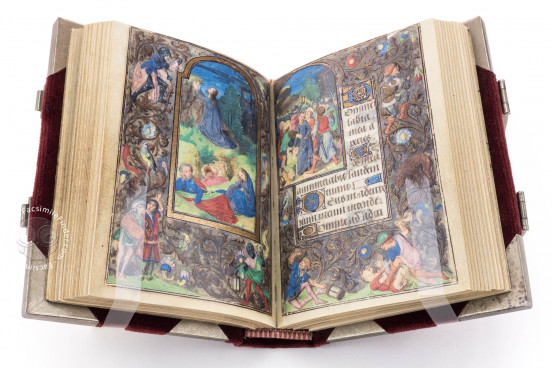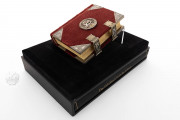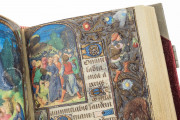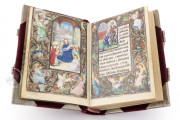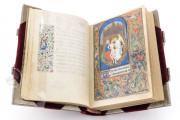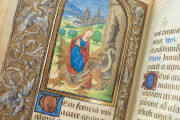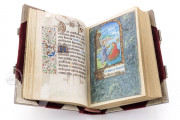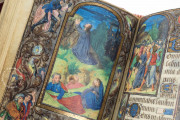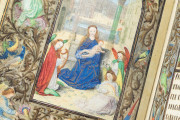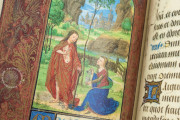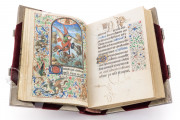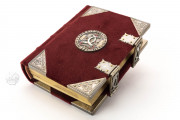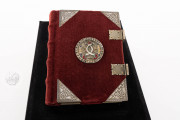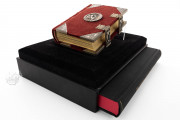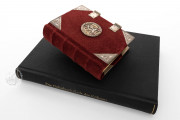Still valid today is Burgundy's reputation as a powerful realm, marked by strict court ceremony and a legendary predilection for luxury, which in the fifteenth century made a considerable impression all over Europe. At that time the old Flemish masters created wonderful works of art which we associate with names like Jan van Eyck or Rogier van der Weyden.
Especially book illumination with its loving treatment of nature provided significant impulses for art. In this period Charles the Bold, Duke of Burgundy, ordered a prayer book for his personal use from Lieven van Lathem, the Viennese Master of Mary of Burgundy, and the scribe Nicolas Spierinc.
Known as the Prayer Book of Charles the Bold, the volume is today kept in the Getty Museum in Los Angeles. It bears testimony to the fact that Europe's most powerful man was indeed unrivalled even in his function as patron of the arts, since every single page of the book is decorated with gold.
According to Antoine de Schryver, the most knowledgeable authority on the Prayer Book of Charles the Bold, the work even holds a "key position in the history of Flemish illumination".
Each Page Lavishly Decorated with Gold
The book, composed of forty-seven miniatures on 159 folios in the format of 12.4 × 9.2 cm, displays the abundant opulence of Burgundian bibliophily. The artist's delight in fantasy is evident throughout, even in the imaginative borders that are populated with countless drolleries, humans, and birds, all set between colored acanthus leaves and tiny golden buds.
Three portraits of the patron remind us of the very personal meaning the book had for Charles the Bold. The lavish decoration also remains a distinctive feature of the written pages. The fine calligraphy of the text is organised around more than 360 initials, mostly on chiselled golden grounds.
Each page of text is additionally decorated with an ornamental border. The Prayer Book of Charles the Bold thus reflects the magnificent opulence of Burgundy, page after page.
Innovative Centre of the Arts
During the lifetime of Lieven van Lathem and the Viennese Master of Mary of Burgundy, Flanders was, along with Paris, Europe's most innovative centre of the arts. Both the rich bourgeoisie and powerful rulers demanded ever more lavishly painted manuscripts and new ideas of artistic expression.
The enormous demand for bibliophile treasures spurred book illuminators to new peak performances, not the least because for the first time in the history of illumination a large part of the work was created for the free market, thus offering talented artists breathtaking career prospects.
Lieven van Lathem: Painter at the Court of Emperor Maximilian
The illuminator Lieven van Lathem was active in the cultural area of Flanders, between Bruges and Ghent, Antwerp and Utrecht. Born around 1430, he first was a member of the painters' guild in Ghent, and later, until his death in 1490, of the St. Luke's guild in Antwerp.
Due to his outstanding talent, he soon became painter to the court of Duke Philip the Good, the father of Charles the Bold. Later he was also called to the court of Emperor Maximilian I.
By the end of the fifteenth century, the Flemish city of Antwerp ranked as the centre of landscape painting; but it was van Lathem with his atmospheric art who had paved the way for this development.
The Viennese Master of Mary of Burgundy: Anonymous but Still Famous
One name is inextricably associated with the painting school of Bruges and Ghent: that of the Viennese Master of Mary of Burgundy, famous for his forceful expressiveness when it came to bringing life to delicate faces or the movement of muscles on parchment.
Although his identity remains unknown, a number of art historians assume him to be Alexander Bening, father of Simon Bening, the last grand Flemish master. He entered the artistic scene with the Prayer Book of Charles the Bold and the world of art immediately got a vivid impression of his unique talent.
The Elegantly Sweeping Script: A Work of Art in Itself
Charles the Bold engaged Nicolas Spierinc, Burgundy's most famous calligrapher, to write his prayer book. Spierinc is not only the author of the wonderful handwriting, he also embellished many pages with so-called cadels, elaborate letters that were decorated with lines in writing ink. Some of the magnificent cadels were even painted in addition with glowing gold, a lustre that is perfectly rendered in the facsimile edition.
The codex is bound in purple velvet and features two gilded clasps, four gilded metal corners on both front and back covers, and a decorative medallion.
We have 1 facsimile edition of the manuscript "Prayer Book of Charles the Bold": Gebetbuch Karls des Kühnen facsimile edition, published by Faksimile Verlag, 2007
Request Info / Price
